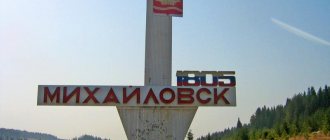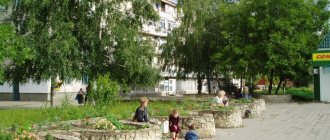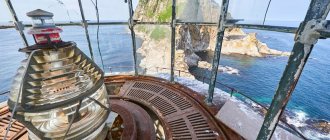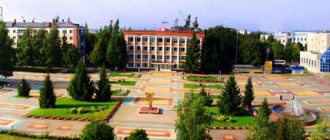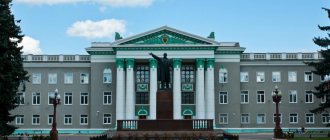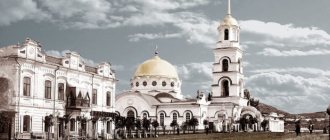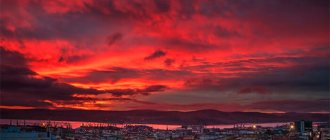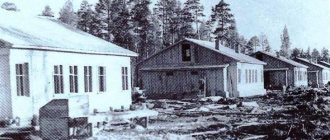You ask, is there life beyond the Arctic Circle? Yes, in city of Murmansk, the administrative center of the region of the same name. The city is famous for the fact that it is three times the “most”: large, young and warm in the Arctic. And also - Murmansk residents love their city on the Kola Peninsula
- for the unique northern lights and youth
- rough sea and hills,
- special sunsets and sunrises, to
- arctic polar vegetation and the warm Gulf Stream,
- for the kindness and sincerity of the inhabitants of this harsh region.
The city of Murmansk is also famous for the fact that it is the last city where the imperial ambitions of the Romanov dynasty were realized. In 1916, the year of his formation, he was called, although only for a short time, Romanov-on-Murman. It received its modern name just 5 months after the bourgeois revolution.
There were no Bolsheviks in the city until the beginning of 1920 - all this time the northern port was under the rule of the rebellious Admiral Kolchak. A run-of-the-mill, provincial town with handicraftsmen and artisans who catch fish - that’s the entire population of two thousand people. And yet, the 20s became a turning point in the fate of the settlement - it began to develop as a strategic bridgehead-port in the north of the Soviet Union.
The fishing port is growing, and a railway connection with Leningrad has been established. By the beginning of the war there were already 120 thousand people in the city. During the war, the city was subjected to intense bombing, and by the time it ended it was completely destroyed, with the exception of the seaport and three buildings.
The Soviet government included it in the state program for the revival of fifteen cities. 100 million rubles allocated from the state treasury were used for the construction of industrial enterprises, berths along the coast of the Barents Sea, construction of housing and infrastructure. After the construction of their house-building plant, the delivery of housing increased significantly; brick housing construction was replaced with prefabricated panel housing.
Population and territory of the city of Murmansk
The city is so small that during the day you can meet the same faces on its streets more than once - almost 300 thousand people live in an area of less than 150 square kilometers. The native townspeople say they have only one street and the Five Corners Square, where they can meet all their acquaintances. The city is indeed very compactly located (stretching for more than 20 kilometers) along the Kola Bay on several terraces.
Statistics claim that the data on the number of city residents is not entirely correct - in recent years, the polar city has seen an outflow of population to other regions. Young people are leaving in search of better jobs. As a result, the demographic situation has worsened - mortality exceeds birth rate by 0.5 percent. This is also explained by the fact that among Murmansk residents there are many who came to restore the city in the fifties and sixties of the last century.
The city had its largest population in the late 80s - more than 450,000 people. During the times of industrial development, the number of city residents increased annually by 8–10 thousand people due to visitors from other regions “for the long ruble” and northern allowances.
In recent years, the economic potential of the region has been growing, small businesses are developing, and there is hope that the number of people in the regional center will reach its historical maximum due to people coming from other regions. High salaries have not been canceled here. To be fair, we note that they are not always official, but young people whose pensions are “beyond the high mountains” are not afraid of this.
The city's population is multinational. Here they live in friendship and harmony:
- Russians
- Ukrainians
- Belarusians
- Tatars
- Germans
- Scandinavian peoples
Work situation
The most popular industry in Murmansk is trade. Other popular areas of activity:
- Logistics.
- Medicine, pharmaceuticals.
- Construction.
- Production.
- Transport, car service.
Where can I get a job?
You can find work in the companies listed in the table.
| Company name | Number of vacancies in 2022 |
| Group of window companies | 1891 |
| Gorenje BT | 1800 |
| Bilinguals | 1740 |
| Industrial Safety Group | 1732 |
| Center | 373 |
| Company group | 335 |
| BY | 173 |
| Youth | 151 |
| Service+ | 135 |
| Alexander | 133 |
Most in-demand professions
In 2022, the following professions are considered in demand:
- Public transport driver.
- Internet manager.
- Office Manager.
- Store manager.
- Online store manager.
- Manager-administrator.
- HR specialist.
- Taxi driver.
The highest paying professions
The following specialists receive high salaries:
- Welder NAKS - 95,000 rubles/month.
- Anesthesiologist-resuscitator - 80,000 rubles/month.
- Driver category "E" - 80,000 rubles/month.
- Taxi driver - RUB 70,000/month.
- Resuscitator - 67,500 rubles/month.
- Crane operator - 60,000 rubles/month.
- Chief engineer - chief technologist - 57,500 rubles / month.
- Designer - 55,950 rub./month.
- Designer-technologist - 55,800 rub./month.
- Process engineer - designer - 55,000 rubles / month.
Climate and ecology of Murmansk
This section needs to be given more attention - those who are planning to change their place of residence to the Arctic are often afraid of the “terrible frosts” and “eternal winter darkness.” Not everything is so simple.
It would seem that in the Arctic Arctic the climate should be harsh, with bitter winter frosts and blizzards. This rule does not apply to Murmansk: the Arctic zone is softened by the Atlantic - the warm Gulf Stream. Therefore, the climate of Murmansk is strikingly different from other polar cities. It is warmer and softer.
Average values in January - February do not exceed 10 - 12 degrees with a minus mark. In winter, winds blow from land, bringing dry, frosty air, while in summer, winds from the Barents Sea predominate, bringing cool and humid air. There are signs of a monsoon climate.
Summer, unfortunately, is cool on the Kola Peninsula. The average temperature in June barely exceeds 10 degrees. The Sami have a warm month of July - get as much as 14 degrees. In August, signs of autumn are already visible, the average temperature is about 8 degrees Celsius. Some years give Murmansk residents amazing heat - over 30 degrees, starting from May and ending in August.
Murmansk has places to cool off in the summer heat - there are dozens of lakes within the city, many of which have recreation areas. What can we say about the Kola Bay!
The Kola Bay almost never freezes, thanks to the warm current, but disasters do happen: at the beginning of 2015, ice up to 8 centimeters thick formed on the water. Forecasters note that in 80 years of observations the bay has frozen for only the sixth time.
Excellent climate, if not for the polar night, which lasts more than 40 days a year from December 2 to January 11. This is real stress for the body of those who have recently moved beyond the Arctic Circle. Doctors say that three years is enough to adapt. There are simple rules that will help a beginner adapt to negative conditions:
- Vitamins
- Fish fat
- Solarium
- Lighting effects
- Hardening
In fact, doctors recommend living in the Arctic for no more than 15 years, and then moving to a more comfortable climate. But few people listen to their recommendations. In this case, it is necessary to leave the north at least once a year and relax in other climatic conditions.
Waiting
To what extent is it correct to call Murmansk a transit space?
Most residents perceive it as an empty place in which they need to stay for some time before real life begins. On the other hand, the temporality of each metropolis is structured in a similar way.
Waiting is the state of the population of any large city, because the environment is organized in the logic of postponed events. The city does not produce emotions here and now; on the contrary, it works in the paradigm of the future tense, a situation that will soon come. A similar thing happened during the process of mass urbanization at the beginning of the last century.
Rural residents who moved to large cities are faced with the collapse of their previous everyday life: the cycle of the day and week has changed, dense communities have split, and household magic has lost its effectiveness.
The calendar, which has become a key metaphor for city life, structures everyday life differently than the year-round cycles of the village. Every day takes on a numerical expression, the meaning of which is the expectation of a weekend, a vacation, a better life, a pension. Mass production and corporate structure, which built a new economic reality, are aimed at creating deferred profits, which fuels interest in the realization of people in their current everyday life under the sign of future benefits. Most infrastructures of a large city operate according to the promise of infrastructure logic described earlier.
However, the urban environment differs from any other not only in the predictability of temporality, but also in the general duality of perception of everyday life. The city is at the intersection of two ways of developing space, as the French researcher Michel de Certeau proves - strategic and tactical.
The first is strategic: planning the environment from above, institutionally shaping the rhythms of everyday life, and endowing places with universal meanings. The names of streets, traffic rules, the construction of new neighborhoods and public spaces - when we talk about planning, design, architecture, we are talking about a strategic way of developing a city.
From above, it seems that the dominant logic is the victorious European rationality, which has turned being in a metropolis into a daily expectation of a better life. The daily routine is subject to the calendar, mechanical clocks, public transport schedules and corporate KPIs. The city strives to make life as predictable as possible, eliminating accidental collisions with its own “wrong side”. The capitalist project of the metropolis truly resembles a hotel lobby and an airport lounge, as Pico Iyer and Siegfried Kracauer noted half a century apart. Rationalization of space is aimed at eliminating any forms of uncertainty and instability. This is why encountering something outside the normal course of everyday life has such a strong psychological effect for residents of big cities.
Here tactical, grassroots forms of development of urban space appear on the scene, emanating not from the authorities, but directly from the users - the citizens. Such development “from below” allows you to redefine the original plan, making the city something personal and unique. Places have their own stories, emotions, and attachments. Streets acquire local names, spontaneous public spaces are created, and new meanings are formed. A tactical way to develop a city is to live here and now. The city no longer acts as a source of external meaning for everyday life, but becomes a canvas where everyone paints a unique picture.
Ancient ways of exploring space are being adapted to a new context. Now fairy tales become urban legends, and everyday magic becomes various kinds of rituals associated with urban space. The townspeople cast a spell on the planes during the flight and tell their children stories about maniacs so that they do not walk through cemeteries at night.
The new environment contains elements that are not provided for in normal everyday life, something that is repressed to the periphery, constantly preserving anxiety with which one has to coexist.
Every city has two faces, and its inhabitants have a unique point of view that contains both perspectives at once—like seeing two sides of an optical illusion. A shift-type settlement is practically devoid of a perspective from below; the minimum comfort of its residents is sufficient to meet their needs for a specified period of time. In contrast, the city does not make its future finite, creating, together with its citizens, an almost perpetual engine for the production of new needs and endowing everyday life with meanings, including through weaving its own meanings into the planned space. In this way, the city becomes an independent agent, and not a place where different actors exert their forces.
Northern Lights in Murmansk
On the polar night, people are delighted by the northern lights - they can last from several hours to several days, whimsically shimmering in different colors. To see the “dance of lights” you need clear frosty weather. By the way, in the city the glow is not visible as clearly as outside it. Experts travel tens of kilometers from the city, to the village of Teriberka.
Not only locals come here, people especially from other cities of Russia rush to this mysterious village to see an unforgettable natural phenomenon and photograph the radiance of color. The path is not short - from Moscow to Tireberka 2000 kilometers.
The Northern Lights can be observed from September 21 to March 21 (equinox guideline), from 21:00 to midnight. You can find out exactly the days of the northern lights on websites for astronomy lovers and plan your visit “for the exotic.”
The polar day is 20 days longer - lasts from May 22 to July 22. For two months the sun does not go below the horizon. Don't think that this is manna from heaven. New residents of Murmansk cannot sleep. According to doctors, the body weakens, tension increases, feelings of anxiety, fatigue, and depression develops. This can be dealt with quite successfully:
- Thick, light-blocking curtains in the bedroom
- Daily routine in accordance with biorhythms
- The surest way is to go on vacation far from the north.
Age and sex composition
Age and sex composition of the urban district as of January 1, 2016[43]
| Total | Men | Women | Murmansk | Murmansk region | |
| Below working age 0-15 | 49863 | 25616 | 24247 | 16,53% | 18,17% |
| Working age 16-54 (f) and 16-59 (m) | 165087 | 95881 | 69206 | 54,74% | 60,57% |
| Over working age | 86622 | 17562 | 69060 | 28,73% | 21,26% |
| Total | 301572 | 139059 | 162513 | 100% | 100% |
Environmental situation in Murmansk
And now - a balm for the soul of those who cannot sit at home! The ecology in the city of Murmansk is one of the best in Russia:
Reducing air pollution levels. This indicator has been recorded by observers since the beginning of 2000.
- The dust content in the air is below sanitary standards.
- Low radiation level – from 8 microR/hour
- The city's comprehensive pollution index is the lowest in Russia, less than three units.
Pollution rates are decreasing every year.
Economics and investment
The strategic location of Murmansk (port city) determines the main sectors of economic development:
- Fish production and processing
- Marine transport and ship repair
- Container Shipping
- Geological exploration and mining
- Metalworking and packaging production
In Murmansk they produce famous canned food from familiar types of fish:
- pike
- Arctic dogs
- cod (liver)
- capelin
- pollock
- haddock,
- blue whiting
- sides
- White Sea herring.
Here you can also try canned food made using original technologies from other commercial species:
- betta
- stingray
- Cucumaria.
Gourmets will love their delicate, slightly smoky taste with flavored butter.
The region has a need for the development of maritime transport, geological exploration (large deposits of nickel, rare and precious metals, and non-metallic materials are concentrated here), and the development of the mining complex. These are promising industries for attracting capital.
In the regional center, as part of the implementation of investment projects, the city's water supply and treatment facilities are being modernized, and an environmental complex is being built.
There is a high demand for workers in the region. In mid-2014, over 13 thousand vacancies were opened, the number of registered unemployed did not exceed 6,200 Murmansk residents. The labor market stress ratio is low.
At the same time, the region is considered unfavorable in terms of payment of wages - the highest overdue payments in the North-Western District: 177 million rubles in the first half of 2014, twice as high as in the previous period.
By the way, the salary of Murmansk residents is in second place in the federal district - about 43 thousand rubles in the region as a whole. In the city it is over 45 thousand rubles. Shows 10 percent annual growth. The cost of fixed goods and services is growing at a high rate and amounted to more than 14 thousand rubles in 2014. Only residents of the Nenets Autonomous Okrug are higher.
Cost of products
Grocery prices in Murmansk look like this:
Cost of fresh vegetables in Murmansk
- Butter - 73 rub.
- Rice - 54.90 rub.
- Bread - 27.40 rub.
- Potatoes - 29.90 rubles/kg.
- Apples - 76.90 rubles/kg.
- Eggs - 80.90 rub./10 pcs.
- Cheese (hard) - 200 rub./100 g.
- Pork - 259 rub./kg.
- Milk - 80 rub./l.
- Flour - 30 rubles/kg.
- Fish - 250 rub./kg.
Watch a video about how much life costs in Murmansk.
Streets and new buildings
Murmansk is a small city with an area of only about 150 km2. However, it is divided into three administrative regions:
- Pervomaisky
- Leninist
- October
The Leninsky district began to be built up just before the start of the Second World War - in 1939. Mostly there are low-rise buildings here, no higher than five floors. The modern area includes the old housing stock - "Khrushchev" and is divided into two parts by the Rost River and Semenovsky Lake.
It is considered the most convenient quarter for living, adjacent to the lake, where townspeople swim in the summer and there is a recreation area. Clean air, silence, absence of industrial enterprises, developed infrastructure, good transport accessibility make this place attractive for new residents.
Very little new housing is being built here - secondary housing predominates, sometimes in very old houses that have long celebrated their 50th anniversary.
There are few apartments for sale in the Leninsky district. Basically, this is an old housing stock. A one-room apartment costs 2,300,000 rubles. The highest prices for housing are located in the area of Geroev-Severomortsev Avenue. Here you will not find apartments cheaper than three million.
On average, the cost of a square meter of housing in this area is 48,931 rubles.
The cheapest housing is in the block adjacent to the Rost River - a one-room apartment can be purchased for 1,550,000 rubles. Low prices are explained by poor internal roads, distance from the city center and poor transport links.
All administrative buildings, shopping and entertainment establishments are concentrated in the Oktyabrsky district. Here is the main city avenue - Lenin. Stalinist buildings and 9-story residential buildings predominate. Accordingly, real estate prices are higher here.
- One-room – 1,983,778 rubles,
- Two-room apartment – RUB 2,684,586,
- Three-room apartment – RUB 3,517,264,
- Four- and multi-room apartments – RUB 5,884,780,
The highest prices in “Stalinka” apartments are the most prestigious city apartments with high ceilings and spacious layouts. The dream of Murmansk residents, in the absence of new construction.
Average prices for apartments in new buildings in the Oktyabrsky district are 57,526 rubles/sq.m.
On the outskirts of the Oktyabrsky district there are many wooden two-story houses, where prices are much lower.
The newest, densely populated area and largest in area is Pervomaisky, with the central Kola Avenue. Here you can see striking contrasts: new houses and wooden barracks in the village of Zhilstroy. Nobody buys housing in the latter: not only is the territory far from being developed, but socially disadvantaged citizens live here.
On average, the cost per square meter of housing in new housing in this area is 48,931 rubles.
In the Pervomaisky district there is a residential area of 9 floors, it is called the “Valley of Comfort” - after the name of the sports complex that is located here. A prestigious and cozy area with developed infrastructure - hence the prices per square meter: from 60 thousand rubles.
The most prestigious microdistrict of the city is “Lights of Murmansk” (the name of the best hotel in the city), where the local elite and businessmen live. Apartments here are rarely put up for sale. The average price per square meter in a fashionable area is 70 thousand rubles.
Local residents rank the city districts where it is best to live: Oktyabrsky, Pervomaisky, Leninsky.
Natural movement
Number of births and deaths (absolute numbers)[41][42]
| 2010 | 2011 | 2012 | 2013 | 2014 | 2015 | 2016 | 2017 | 2018 | 2019 |
| Births | 3285 | 3295 | 3373 | 3486 | 3381 | 3749 | |||
| Deaths | 3735 | 3560 | 3536 | 3453 | 3479 | 3597 | |||
| E.p | -450 | -265 | 163 | 33 | -98 | 152 |
Fertility, mortality, natural increase per 1000 people.[42]
| 2010 | 2011 | 2012 | 2013 | 2014 | 2015 | 2016 | 2017 | 2018 | 2019 |
| Fertility | 10,69 | 10,80 | 11,15 | 11,65 | 11,08 | 12,43 | |||
| Mortality | 12,15 | 11,67 | 11,69 | 11,54 | 11,40 | 11,93 | |||
| E.p | -1,46 | -0,87 | -0,54 | 0,11 | -0,32 | 0,50 |
Attractions
In addition to the Northern Lights, guests of the city can see other attractions, although there are few of them - the city is not even a hundred years old.
The guests examine with curiosity the first Soviet nuclear-powered icebreaker "Lenin", which is laid up in the port. For children, visiting the ship evokes unearthly delight.
A memorial to the defenders of the Soviet Arctic, crowned by the famous Murmansk Alyosha, rises above the city. It is located in the area of Semenovskoye Lake.
The world's northernmost aquarium is also located here. Visitors can see funny performances of marine life from northern latitudes.
Near the lake there is a modern monument associated with the tragic death of the Kursk submarine.
The visiting card of the modern city is the newly built lighthouse and the Church of the Savior on the Waters.
The last city founded under the Russian Empire
Murmansk, which currently has a population of 301.5 thousand, was founded in 1916, although plans for a port city began to appear in the 1870s. The main purpose of creating the settlement was the desire of the Russian Empire to gain access to the Arctic Ocean through the gulf, which does not freeze, so that in the event of a blockade of the seas, the Black and Baltic, to be able to supply and receive cargo.
Initially, the city was a small village of Semenovsky at the Murmansk seaport. The official founding date of the settlement is the day of foundation of the temple in honor of the patron saint of sailors. Murmansk (the population at the time of its founding consisted mainly of workers and members of their families) became the last settlement that was founded during the Russian Empire, and received its modern name six months after the February Revolution. Until this moment, the settlement was called Romanov-on-Murman.

